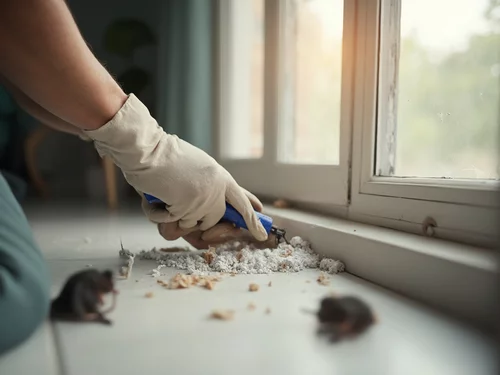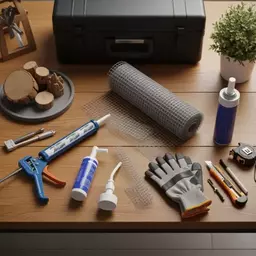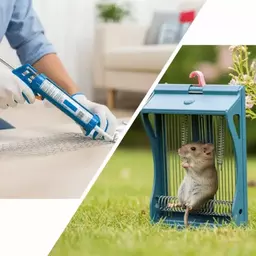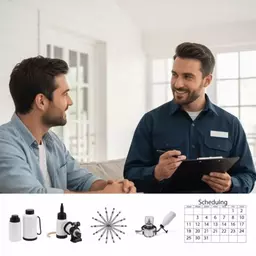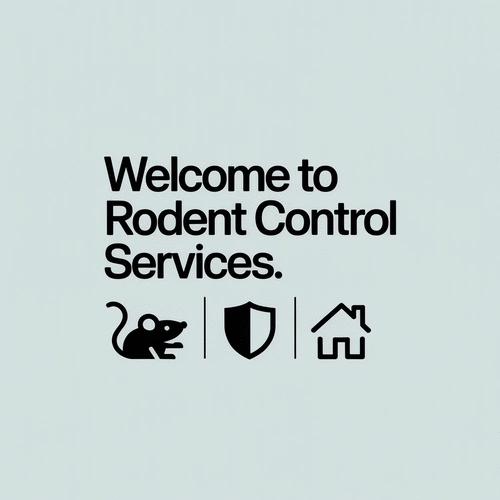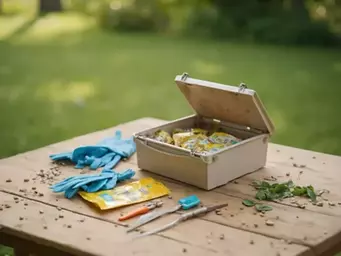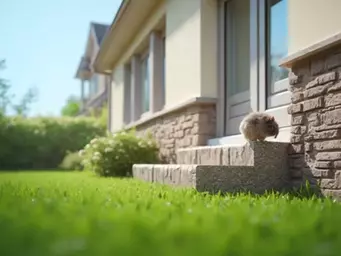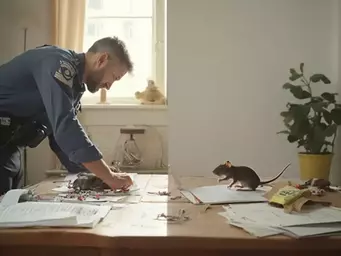Have you ever noticed how a small crack can open the door to a big problem? When it comes to rodent infestations, even the tiniest gap can lead to significant health and property issues. Understanding the importance of rodent exclusion is essential for maintaining a safe and comfortable environment. Let’s dive into the key takeaways that can help you stay one step ahead!
What You Will Learn
- Rodent exclusion prevents health risks associated with rodent infestations, such as disease transmission.
- Sealing entry points as small as a quarter is crucial to protect your home or business from rodent access.
- Maintaining cleanliness by managing food storage and waste helps make your environment less inviting to rodents.
- Regular inspections can identify new vulnerabilities, ensuring long-term rodent prevention strategies are effective.
Rodent Exclusion: Key Steps & Risks
Understanding rodent exclusion involves a clear process of prevention and mitigation. This visual outlines the critical steps to secure your property and highlights the primary risks associated with rodent infestations.
Process Flow Key Rodent Exclusion Steps
- 1 Thorough inspection to identify entry points.
- 2 Seal gaps and holes with appropriate materials.
- 3 Maintain a clean environment (food/waste).
- 4 Regular inspection for new vulnerabilities.
Impact Assessment Rodent Infestation Risks
- × Health risks: hantavirus, leptospirosis, salmonella, allergies.
- × Property damage: gnawing wires (fire hazard), structural damage.
- × Contamination: droppings on food and surfaces.
- × Increased pest control costs in the long run.
Understanding Rodent Exclusion: Why It Matters for Your Home and Business
When it comes to creating a safe and comfortable environment, understanding rodent exclusion is crucial. Rodent exclusion is the practice of preventing rodents from accessing your home or business. This process not only protects your property but also your health and peace of mind. As a pest management expert, I can tell you that neglecting this aspect can lead to significant challenges down the line.
By focusing on rodent exclusion, you take proactive measures against potential infestations. This means not only sealing entry points but also creating an environment that is less inviting to these unwanted guests. Have you ever seen a mouse scurry across your living room? It’s a sight that can send chills down anyone’s spine!
Defining Rodent Exclusion and Its Importance
At its core, rodent exclusion involves identifying and sealing off all possible entry points that rodents can use to invade your space. This is particularly important because rodents can squeeze through surprisingly small openings. A gap as small as a quarter can be an entryway for a mouse! By implementing rodent exclusion techniques, you can significantly reduce the risk of infestations and the associated costs of dealing with them.
- Prevention of health risks associated with rodents.
- Protection of your property from damage.
- Reduction of pest control costs in the long run.
Implementing effective rodent exclusion methods means investing in your property’s integrity and your family’s safety. It’s a smart decision that pays off in more ways than one! For further insights into effective rodent exclusion practices and preventing rodents from overwintering in your home, you can refer to resources from UC ANR.
The Health and Property Risks of Rodent Infestations
Rodents are not just a nuisance; they also pose serious health risks. They can carry diseases such as hantavirus, leptospirosis, and salmonella, which can be transmitted to humans. Additionally, they can trigger allergies and asthma in sensitive individuals. These health concerns underscore the importance of maintaining a rodent-free environment.
- Rodent droppings can contaminate food and surfaces.
- Gnawing damage to electrical wires can lead to fire hazards.
- Structural damages from nesting and burrowing.
For your home or business, the presence of rodents can lead to costly repairs and health issues. That's why investing time in rodent exclusion is not just wise; it's essential for your well-being and peace of mind. You can learn more about the significant damage rodents can cause to homes and businesses by chewing through electrical wires and other materials from this UNL Extension publication.
Pro Tip
Did you know? Regularly inspecting your property for signs of rodent activity can save you significant time and money in the long run. Even small preventative measures, like keeping trash tightly sealed and reducing clutter, can deter rodents from making your home their new habitat.
Frequently Asked Questions About Rodent Exclusion
What is rodent exclusion?
Rodent exclusion is the practice of preventing rodents from entering your home or business by identifying and sealing off all possible entry points. It's a proactive measure to protect your property and health from infestations.
Why is rodent exclusion important?
Rodent exclusion is crucial for preventing significant health risks (such as diseases like hantavirus and salmonella), property damage (like gnawing on wires and structural elements), and contamination of food and surfaces. It also reduces long-term pest control costs.
How small of an opening can rodents squeeze through?
Rodents, especially mice, can squeeze through surprisingly small openings. A gap as small as a quarter (approximately 1/4 inch or 6mm) can be enough for a mouse to gain entry.
What are the key steps in effective rodent exclusion?
The key steps include conducting a thorough inspection to identify entry points, sealing gaps and holes with appropriate materials (like steel wool, caulk, or hardware cloth), maintaining a clean environment by managing food storage and waste, and performing regular inspections for new vulnerabilities.
What are some common materials used for sealing entry points?
Recommended materials include rodent-proofing caulk for smaller gaps, heavy-duty steel wool for blocking holes, and hardware cloth for larger openings.
What is Integrated Pest Management (IPM)?
Integrated Pest Management (IPM) is a holistic approach to pest control that combines various methods for long-term prevention. It includes regular monitoring, using mechanical, cultural, and biological control methods, and educating individuals about pest behavior and prevention techniques.
Recap of Key Rodent Exclusion Steps
As we wrap up our discussion on rodent exclusion, it's essential to remember the effective strategies that can help keep your property free from these unwelcome guests. Rodent exclusion is not just about immediate fixes; it's about creating a robust defense that protects your home or business for the long term. By following these key steps, you can significantly reduce the risk of rodent infestations:
- Conduct a thorough inspection to identify vulnerable entry points.
- Seal gaps and holes using appropriate materials like steel wool, caulk, or hardware cloth.
- Maintain a clean environment by managing food storage and waste disposal.
- Establish regular inspection routines to monitor for new vulnerabilities.
By implementing these steps, you’re not only safeguarding your space but also fostering a healthier environment for your family or employees. Remember, prevention is key!
Encouragement for Proactive Rodent Prevention
At Rodent Control Services, we believe that proactive measures are the best approach to rodent management. It’s easy to overlook those small cracks and gaps, but I urge you to take the time to assess your property regularly. Taking action now can save you time, money, and stress later! Every little effort counts, from sealing potential entry points to keeping your surroundings tidy. The Yale School of the Environment highlights how energy-efficiency improvements can also help keep rodents at bay by reducing gaps and sealing your home tighter.
Consider this: the more diligent you are about these practices, the less likely you are to face a rodent problem in the future. And if you ever feel unsure about any aspect of rodent exclusion, don’t hesitate to reach out for help. Together, we can ensure your environment remains a rodent-free haven!
Taking the Next Steps: Resources and Professional Support
Links to Recommended Tools and Materials
To assist you in your rodent-proofing journey, I’ve compiled a list of recommended tools and materials that you might find useful:
- Rodent-proofing caulk for sealing gaps.
- Heavy-duty steel wool for blocking entry points.
- Hardware cloth for larger openings.
- High-quality traps for monitoring rodent activity.
These resources can make a significant difference in the effectiveness of your rodent exclusion efforts. Invest in quality materials, and you’ll be better equipped to fight off these intruders.
Finding Local Rodent Control Services for Additional Help
If you find that your rodent problems persist or if you want a professional touch, it’s always wise to enlist the help of local pest control services. At Rodent Control Services, we’re dedicated to providing comprehensive solutions tailored to your needs. Here are some tips for finding the right help:
- Look for providers with strong customer reviews and testimonials.
- Check for services that offer both residential and commercial pest control.
- Ensure they follow sustainable practices in their pest management techniques.
By choosing a reputable service, you can rest easy knowing you’re in capable hands.
Understanding Integrated Pest Management Strategies
Finally, I encourage you to explore Integrated Pest Management (IPM) strategies. This holistic approach not only addresses current pest issues but also lays the groundwork for long-term prevention. IPM practices include:
- Regular monitoring of pest activity.
- Using a combination of mechanical, cultural, and biological control methods.
- Educating yourself and your team about pest behavior and prevention techniques.
With IPM, you’ll have a comprehensive strategy that empowers you to take control of your rodent situation effectively. Remember, the goal is to create an environment that’s less attractive to rodents, leading to a significant reduction in infestations. Together, we can maintain a safe and welcoming space for everyone!
Recap of Key Points
Here is a quick recap of the important points discussed in the article:
- Rodent exclusion is essential for protecting your home or business from infestations and health risks.
- Identify and seal entry points as small as a quarter to prevent rodent access.
- Maintain cleanliness by managing food storage and waste disposal to deter rodents.
- Regular inspections are crucial to monitor for new vulnerabilities and maintain a rodent-free environment.
- Consider using Integrated Pest Management (IPM) strategies for long-term pest control solutions.

